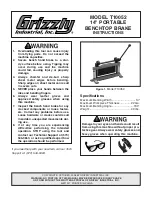
-4-
T10052 14" portable Benchtop Brake
Finger & Die Removal
For pan & box style bends, you will need to
remove one or more of the fingers or dies to avoid
bending certain areas of the workpiece.
To remove the fingers and dies:
1.
remove any workpieces from the brake.
2.
determine which fingers and dies must be
removed to accomplish the desired bend.
see
Figure 9
for an overview of how to create
pan & box style bends to help you determine
which fingers and dies must be removed for
your particular operation.
Note:
Any areas to be bent must be fully
supported by the dies and the fingers must
press into the entire crease. Failure to prop-
erly position the fingers and dies will produce
poor results.
9Zh^gZY7ZcY
6a^\c
Ldg`e^ZXZ
L^i]
;^c\Zg
GZbdkZ
;^c\Zgh
VcY9^Zh
8gZViZ
7ZcY
Figure 9.
Pan & box bending.
Creating Bends greater than 135°
The greatest angle that the Model T10052 can
produce in a single bend is approximately 135°.
To create angles greater than this, a second step
must be performed.
To create an angle greater than 135°:
1.
Follow
Steps 1–2
from
Basic Operations
on
Page 3
to align the workpiece in the brake.
2.
pull the handle all the way down to create the
maximum bend, then return the handle and
remove the workpiece.
3.
place the workpiece as shown in
Figure
8
.
4.
pull the handle down until the desired bend is
created
5.
use a protractor or similar device to check
that the bend meets your requirements.
6.
repeat
Steps 3–5
as necessary.
Figure 8.
Positioning for bends over 135°.


























